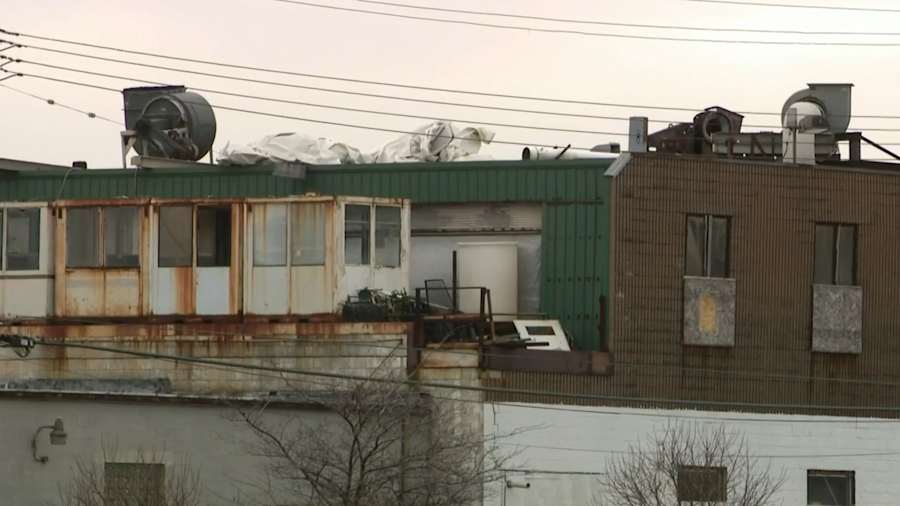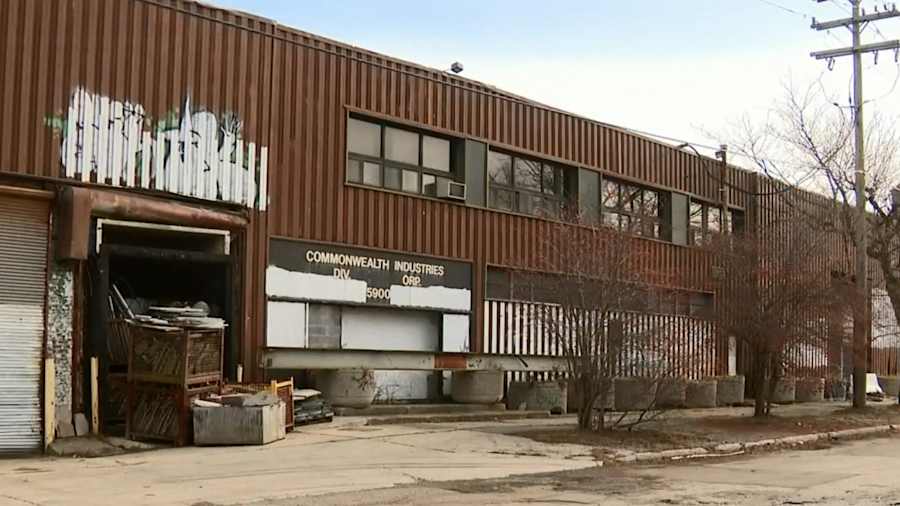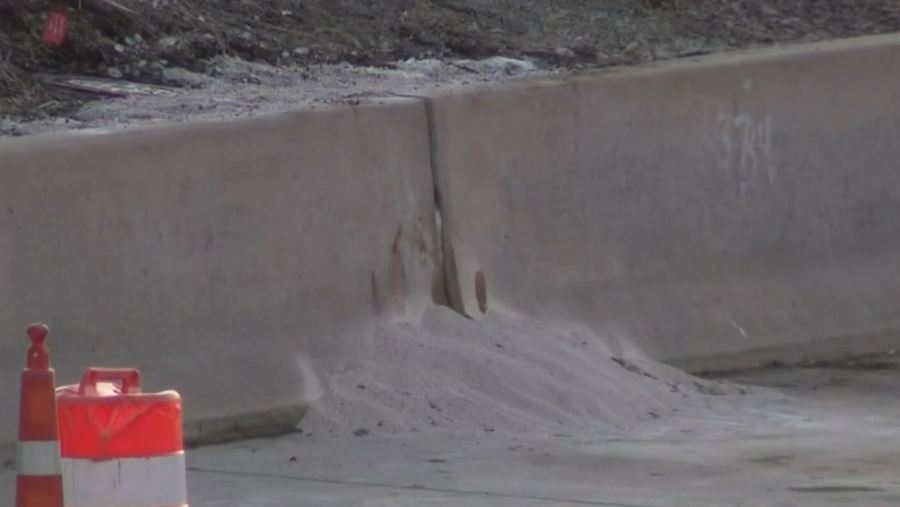MADISON HEIGHTS, Mich. – The discovery of a green substance seeping onto I-696 in Madison Heights last month led to an investigation into just how far contamination may have spread.
The substance, identified as hexavalent chromium, was discovered on the eastbound side of the roadway, near the Couzens Road exit, on Dec. 20, 2019.
Recommended Videos
The Environmental Protection Agency recently created a page on its website dedicated to the site.
Where is it coming from?
Officials said the substance is coming from the basement of the now-condemned Electro-Plating Services on 10 Mile Road, which was the site of a massive cleanup in 2016 due to improperly stored hazardous waste.
The business had been cited by state officials for lack of compliance for nearly two decades before it was finally permanently closed after the complaints received in 2016.
MORE: Contamination near Madison Heights business follows decades of violations
Inspectors previously found an estimated 5,000 containers of hazardous waste and materials that were improperly stored, unlabeled, open and corroded or in very poor condition at Electro-Plating Services.
While the site was cleaned up, it didn’t qualify for the level of funding that could have prevented the current mess.
Below are photos of what officials found inside the business at that time:
Sludge drying in basement -- hazardous waste used as berm material (WDIV)
The business owner, Gary Sayers, headed to prison recently after he pleaded guilty to storing hazardous waste without a permit.
READ: Madison Heights to take man responsible for I-696 contamination to court
The city is taking him to court in an attempt to get him to demolish the Electro-Plating Services building. Officials said the city will demolish the site if he does not comply.
MORE: Trial held as city fights to get condemned building demolished
On Jan. 10, test results showed there are high levels of PFOS in the Electro-Plating building.
How did it get there?
Officials said the substance moved from the basement of the business into the ground, where it contaminated groundwater. From there, it made its way to a drain that goes to the freeway.
MORE: Cyanide, other contaminants found near condemned Madison Heights business
It was oozing from the embankment.
Alexandra Lynn Clark, the enforcement manager for materials with the Department of Environment, Great Lakes, and Energy, explained why there was contamination still, despite the past cleanup.
"Because of the amount of drainage and contents of contaminants in that pit over 30-odd years, would lend itself to the building materials themselves becoming substantially contaminated, and those things weren’t removed,” she said. “That residual contamination can reenter or become mobilized by groundwater flow into the building.”

What is it?
The substance was identified as hexavalent chromium.
EGLE said there is no threat to drinking water, but that there are high levels of multiple contaminants in the soil and groundwater near the now-condemned Electro-Plating Services.
Chromium, trichloroethylene (TCE) and cyanide were all discovered near the building.
Hexavalent chromium was found at at 0.14 milligrams per liter. The standard for drinking water is 0.10 milligrams per liter.
Read more: Substance made famous by Erin Brockovich is what was seeping onto I-696
The storm sewer eventually enters Lake St. Clair miles away, EGLE said. By the time the substance would get to the lake, “concentrations would be well below detectable levels although still a significant concern for incremental accumulation in the ecosystem,” EGLE said.
Hexavalent chromium is often produced during industrial processes. The chemical is known to cause cancer and targets the respiratory system, kidneys, liver, skin and eyes, according to the Occupational Safety and Health Administration.
According to the EGLE, the “release likely contributed contaminants to the storm sewer system before it was discovered.”

How far did it spread?
Officials are trying to determine how far the contamination has spread.
The EPA had crews digging and taking soil samples from about 20 feet into the ground near the site on Jan. 6 to see how deep the contamination went.
The samples will be sent to a lab to determine how deep the hexavalent chromium and other chemicals have spread through the ground and through the water. Investigators can’t speculate how long the Madison Heights site has been leaking.
Officials are awaiting those results.
The drain system on the freeway dumps into the Clinton River, which eventually leads to Lake St. Clair, so officials say it is likely the substance made it to the lake.
More: Officials say green contaminant on I-696 is likely headed to Lake St. Clair
Other concerns
Meanwhile, the investigation has led crews to other sites, including property Sayers owns and a building in Detroit.
Officials said they found an increase in scrap metal and empty containers since a 2017 visit to Sayers’ Deckerville property.
READ: Could the man responsible for contamination at Madison Heights site have also done it elsewhere?
An empty 300 gallon plastic tote was found in a creek on the property. State investigators said the water in the creek is clear,
Initial reports indicated no hazardous waste, but the EGLE has been at the site investigating again. Crews are expected to return to the site in a couple of weeks with gear to see if anything is buried at the property.
A Detroit fire inspector was at the Commonwealth Industry building Jan. 7 in connection with the contamination investigation after receiving a tip that Sayers may have stored hazardous chemicals there.

The building on Commonwealth Street, west of the Lodge Freeway and north of I-94, appears to now be empty.
Public record searches show the building was at one point owned by Sayers.
Crews went inside the building Jan. 10 and discovered several 8-foot by 10-foot concrete pits that contain a substance that appears to be the same one found on the freeway.
A violation was issued in 2005 because Sayers was apparently moving hazardous material from the Electro-Plating Services business to the Commonwealth building. Clark said there were more than 500 drums of hazardous materials identified that had been transported from Madison Heights to Detroit.
Further inspections and testing will be done at the Detroit building.
Officials said they are in the process of condemning the building. It will be boarded up so people can’t get inside.
Documents show that there is a long history between Sayers and the city of Detroit.
What is being done?
The far right lane of eastbound I-696 at Couzens Road has been closed since Dec. 20.
CHECK: Traffic Map
The immediate threat was handled, but officials have been working on a long-term solution.
Tricia Edwards, with the EPA, said the cleanup is going to take time because there is a lot of clay in the area, and the substance is traveling onto the clay.
MORE: Officials working on long-term solution for contamination near I-696
“The green liquid has significantly impacted the embankment where it came out, so we will be working with partners to see what sort of remediation will be required to clean that up,” said Jill Greenberg, the EGLE spokesperson.
A basement sump was being used collect and remove water from the basement into a portable tank, Greenberg said. She said it reduces the water migrating off site.
It is a temporary system that will remain under oversight from the EPA and EGLE until a long-term solution is in place.
Greenberg said townhall meetings to discuss the issue with residents are being planned.
Cleanup efforts underway include:
- Daily vacuuming of nearby catch basins.
- Maintenance and inspection of sump pumps collecting contaminated water from both inside the facility and on the highway embankment.
- Daily monitoring of air in the building using hand-held monitors.
- Preparing for the impact of rain and freezing weather.

Legislators release statement
On Monday, Sen. Jeremy Moss (D-Southfield) and Rep. Jim Ellison (D-Royal Oak) issued the following joint statement:
“The news this weekend of a hazardous waste oozing on I-696 in Madison Heights is alarming. We’ve been communicating with those who are working to contain and clean up the site and are grateful for their swift response in monitoring this issue. Preventable situations such as this are why we must act with urgency to enforce stronger policies to hold polluters accountable and protect our residents. As our constituents join with their loved ones this week during the holiday season, we will continue to work with local, state and federal officials on cleanup efforts and will ensure residents are informed of any development of this ongoing situation."
Sen. Paul Wojno (D-Warren) and members of the Macomb legislative delegation released this statement:
“The news that hexavalent chromium, a known carcinogen, was seeping onto I-696 on Friday is yet another wakeup call that we must take environmental threats seriously. Whether it’s chromium-6, PFAS or lead, we are facing a serious public health crisis in this country because these chemicals can leach into soil and contaminate our water supply. There is no room for complacency in situations like this. Our Macomb legislative delegation is working to ensure clean-up efforts are conducted properly, that Lake St. Clair is protected and those responsible are held accountable, and that the public is kept informed as additional information is provided to us."
Macomb County Public Works Commissioner Candice S. Miller also released a statement:
“Michigan EGLE and EPA were quickly on the job and engaged in this clean up on what was essentially a holiday weekend. This issue points out the need to monitor and have a means to capture the storm water off our major freeways – which amounts to millions of gallons of water per year directly entering into Lake St. Clair and the Great Lake system,” Miller said. “This cleanup will continue through the holiday week and we appreciate this dedication. While we applaud the actions taken initially to clean up the business site where this hexavalent chromium was illegally stored, we are concerned by initial reports that the groundwater around this business was not tested or remediated, allowing this leakage on to I-696 to occur. It has been reported that $1.5 million was spent on this clean up, so to hear that the groundwater wasn’t at least tested, that raises concerns. We cannot continue to operate the way that we have in the past. The Great Lakes are a world treasure and we must work together to serve as their guardians. A single drop of this chromium 6 contamination that might enter the lake is one drop too much."






























































